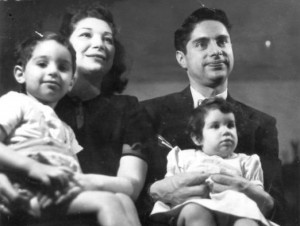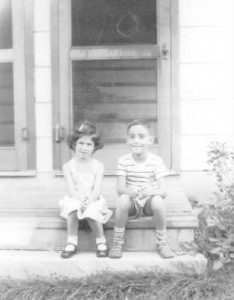
Greenbelt was one of three planned communities created by the federal government during the Franklin Roosevelt administration. Built on farmland in Maryland’s Prince George’s County, near Washington, it began housing applicants, mostly young families and government workers, in 1937. Applicants were carefully screened, and were expected to embrace the concepts of community cooperation and volunteerism. African-Americans were not allowed to apply.
At the beginning, residences were duplex apartments in simple buildings that encircled a small retail center, which included a grocery store, movie theater, community center and public school. Among other things, Greenbelt was noted for having sidewalks and paths that tunneled under the main roads, so children did not have to encounter motor vehicles.
I lived in Greenbelt from 1948 to 1951, and returned for a visit last year for the first time in 55 years. Several months later, I serendipitously met former Greenbelt resident Beulah Bukzin in Massachusetts, and interviewed her and Beulah’s daughter Frances Lapidus. The following article is based on that interview.
“I had the most wonderful childhood. I thought we were the luckiest people in the world. I was never envious, because we all had about the same things. We all had Chevys and Plymouths and Fords. All the dads went to work early and came home at dinnertime. All the moms were home. We lived in a bubble. It was just not real.”
The nostalgic words of Fran Lapidus vividly reflect Rexford Tugwell’s utopian vision 70 years ago. Fran was born in Greenbelt in 1944, the second of two children of New York City natives Beulah and Elliott Bukzin. When they moved to Greenbelt in 1943, they unwittingly became part of an experiment in social engineering that for them would turn out to be, in Beulah’s words, ‘a happy time.’
The Bukzins were living in a basement apartment in Takoma Park, Maryland. Elliott worked for the Bureau of Ships in Washington, and Beulah was pregnant with her first child.
“I was thinking that Greenbelt would be nice for the baby. Elliott drove over, and it was a pile of mud where they were going to put the houses. He was interviewed by a social worker. After Mitchell was born, we moved into a two-bedroom apartment at 11F Hillside Road.”
“It was all young people with little children. Everybody worked for the government. The men organized carpools right away. We had a babysitters club. I came out of New York where everybody I knew was Jewish, but it never bothered me whether or not the other residents were Jewish. It was just the sweetest neighborhood.”
The Bukzins were very involved with Greenbelt’s Jewish community, especially when the Jewish Community Center (now Mishkan Torah) was built in the early 1950s. That was when Elliott was president of the Shul.
“They called it the building,” says Beulah. They’d say, ‘Are you going to the building?’ It took three years. At our first service, we had a visiting rabbi from the armed services. Then he moved to Greenbelt and became the rabbi and still kept his government job.”
Fran recalls: “Every single weekend, the men would work all day on the building until it got dark. They had to give up their handball and pinochle games. I brought them lemonade. They shared their expertise as electricians or plumbers and other things. My mother had family members that were in the textile business, and they donated fabric for the draperies. Practically the whole town went to the first service. It was a real big deal, with a ribbon cutting.”
The family moved to 34L Ridge Road just before Fran was born, and then bought one of the new brick homes at 6N Ridge six years later. Fran wasn’t pleased.
“I missed the neighborhood. It was a long walk to go back there, and there were no underpasses. When we were at 34L, we were close to the maintenance road. My grandfather gave my brother a beautiful tricycle that had gears and went very fast, and I remember trying to chase him in my little tricycle up and down that road.”
Beulah might view Fran’s move across town and her so-called long walk back to her neighborhood as hardly worth mentioning compared to the travels and struggles of her immigrant ancestors.
“My father was Irving Weiss. He was born in Bulgaria. He came to New York City as a child around 1900. He ran away from home to go west when he was fourteen. He hopped a train with a friend and went out to see the Indians and whatever else they had there. When he came back, he joined the Merchant Marines.”
“He finally became a salesman, and he would go out into the countryside for different companies, start in Philadelphia and go all the way west, and stop in the shops. He sold carpets and rugs. He was away a lot, sometimes two or three weeks, sometimes longer if things were going good.”
“We lived in Brooklyn, but we moved a lot ― all within Brooklyn – until I got older, when we lived in Chicago and Cleveland for a while. Then we moved back to New York. When I graduated from high school, I wanted to go to college, but it didn’t work out. The girls in my circle didn’t think about education. My mother didn’t either. Girls who went to college were girls their parents thought were not marriageable. They became teachers.”
Elliott and Beulah left Greenbelt and bought a house in Silver Spring, Maryland in 1964, two years after Fran enrolled at the University of Maryland. Ten years later they moved to Florida. Elliott passed away four years ago, and Beulah now lives in Williamstown, Massachusetts, near Fran, who is married and is Associate Director of Admissions for Williams College.
Life in the Berkshires is 400 miles and several generations away from Fran’s old neighborhood.
“We were always outdoors playing, but my children grew up here and had to make an appointment to go outside and play with their friends. In Greenbelt, as soon as dinner was over, there would be someone knocking at our door.”
Beulah adds: “Greenbelt was a happy time. The children were safe. There was something about not having to worry about your kids crossing the street and having enough kids to play with.”
For the Bukzins of Ridge Road, Greenbelt remains a big part of their lives. Fran’s eyes light up as she explains:
“All my best friends today are Greenbelt girls. My mother’s dearest friends are still her Greenbelt girlfriends. Most of them moved to Florida about the same time. She had her mah-jongg gang down there. Some of them traveled north for our Bar Mitzvahs.”
“Whenever I get together with other Greenbelt people, it’s just a bond that we have that is very special. I think we had sort of an unreal childhood, like we lived in Pleasantville. I knew who I was, and there wasn’t any hindrance in doing the things that I wanted to do.
“I get to go back sometimes, because I visit high schools there for my admissions job. When I went back for my father’s memorial service, I showed my kids where I used to live. I couldn’t believe that everything looked so small. What we called the woods was just a clump of trees.”
